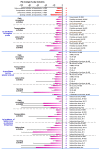Exploring the Impact of COVID-19 on Physical Activity One Month after Infection and Its Potential Determinants: Re-Infections, Pre-Illness Vaccination Profiles/Types, and Beyond
- PMID: 37766108
- PMCID: PMC10538036
- DOI: 10.3390/vaccines11091431
Exploring the Impact of COVID-19 on Physical Activity One Month after Infection and Its Potential Determinants: Re-Infections, Pre-Illness Vaccination Profiles/Types, and Beyond
Abstract
This study investigated changes in physical activity (PA) after severe acute respiratory syndrome coronavirus 2 (SARS-CoV-2) infection while considering age, PA level, underlying medical conditions (UMCs), vaccination profiles/types, re-infections, disease severity, and treatment. Data were collected from 5829 respondents by using a validated web-based questionnaire. The findings showed that there was a significant overall decrease in PA (-16.2%), including in daily occupation (-11.9%), transportation (-13.5%), leisure-time (-16.4%), and sporting (-27.6%) activities. Age, PA level, UMCs, vaccination profiles/types, disease severity, and treatment played a role in determining PA in individuals' post-acute SARS-CoV-2 infections. Re-infections did not impact the decline in PA. Unvaccinated individuals experienced a significant decline in PA (-13.7%). Younger (-22.4%) and older adults (-22.5%), those with higher PA levels (-20.6%), those with 2-5 UMCs (-23.1%), those who were vaccinated (-16.9%) or partially vaccinated (-19.1%), those with mRNA-type vaccines only (-17.1%), those with recurrent (-19.4%)-to-persistent (-54.2%) symptoms, and those that required hospital (-51.8%) or intensive care unit (-67.0%) admission during their infections had more pronounced declines in PA. These findings emphasize the complex relationship between post-acute SARS-CoV-2 infection and PA and highlight the need for targeted interventions, further research, and multidisciplinary care to promote PA resumption and mitigate long-term effects on global public health.
Keywords: Long COVID; cross sectional; exercise; mRNA; performance; post-COVID-19 conditions (PCCs); post-acute Sequelae of SARS-CoV-2 infection (PASC); public health; retrospective; viral vector.
Conflict of interest statement
The authors declare no conflict of interest.
Figures



Similar articles
-
Analysis of a comprehensive dataset: Influence of vaccination profile, types, and severe acute respiratory syndrome coronavirus 2 re-infections on changes in sports-related physical activity one month after infection.Data Brief. 2023 Oct 24;51:109723. doi: 10.1016/j.dib.2023.109723. eCollection 2023 Dec. Data Brief. 2023. PMID: 37965614 Free PMC article.
-
Impact of COVID-19 Lockdown on Physical Activity in a Sample of Greek Adults.Sports (Basel). 2020 Oct 21;8(10):139. doi: 10.3390/sports8100139. Sports (Basel). 2020. PMID: 33096721 Free PMC article.
-
Severe acute respiratory syndrome coronavirus 2 vaccine breakthrough infections: A single metro-based testing network experience.Front Med (Lausanne). 2022 Nov 25;9:1031083. doi: 10.3389/fmed.2022.1031083. eCollection 2022. Front Med (Lausanne). 2022. PMID: 36507539 Free PMC article.
-
Post-Acute Sequelae After Severe Acute Respiratory Syndrome Coronavirus 2 Infection by Viral Variant and Vaccination Status: A Multicenter Cross-Sectional Study.Clin Infect Dis. 2023 Jul 26;77(2):194-202. doi: 10.1093/cid/ciad143. Clin Infect Dis. 2023. PMID: 36905145 Free PMC article.
-
Adverse outcomes of SARS-CoV-2 infection with delta and omicron variants in vaccinated versus unvaccinated US veterans: retrospective cohort study.BMJ. 2023 May 23;381:e074521. doi: 10.1136/bmj-2022-074521. BMJ. 2023. PMID: 37220941
Cited by
-
Analysis of a comprehensive dataset: Influence of vaccination profile, types, and severe acute respiratory syndrome coronavirus 2 re-infections on changes in sports-related physical activity one month after infection.Data Brief. 2023 Oct 24;51:109723. doi: 10.1016/j.dib.2023.109723. eCollection 2023 Dec. Data Brief. 2023. PMID: 37965614 Free PMC article.
References
-
- World Health Organization Statement on the Fifteenth Meeting of the IHR (2005) Emergency Committee on the COVID-19 Pandemic. [(accessed on 5 May 2023)]. Available online: https://www.who.int/news/item/05-05-2023-statement-on-the-fifteenth-meet....
-
- Cohen K., Ren S., Heath K., Dasmariñas M.C., Jubilo K.G., Guo Y., Lipsitch M., Daugherty S.E. Risk of persistent and new clinical sequelae among adults aged 65 years and older during the post-acute phase of SARS-CoV-2 infection: Retrospective cohort study. BMJ. 2022;376:e068414. doi: 10.1136/bmj-2021-068414. - DOI - PMC - PubMed
LinkOut - more resources
Full Text Sources
Miscellaneous

